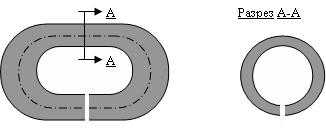Magnetic pulse
A.D. Rudnev, , V.F. Laptev
We wanted to visualize the magnetic flux in the transformer core. No doubting the truth of the book, we assumed that the magnetic flux "flows" by force line core (Fig. 1).

Fig.1. Transformer
Just note that we didn't find the axial motion of the electrons in the core (at least within the resolution of measuring devices). And for the registration of the vortex current we needed to try very hard. We have made a C-shaped core made of iron pipe (Fig. 2). This letter he recalled, both by appearance, and by the figure section.

Рис.2.The form of core
By placing on this core a few turns of the coil, we made in it rectangular current pulses. The first mystery - the potential difference in the profiles of the core is exactly the same as current shape. Later, this effect has been revealed - it was the simplest spatial compression effect of free electrons in the magnetic conductor on vector of the magnetic forces. But appearance of a potential difference in the gap of cross-section remained a mistery. We had no choice but to observe the induced EMF in mutually perpendicular directions. Connection coil at the core solved the problem only for the axial flow. The recorded EMF pulse is a short sharp pulse with exponential decay.
To register a component of the magnetic vortex momentum, we drilled two holes located on the axis of the core. A few turns of wire, covering the bridge between the holes, have enabled to recieve the EMF of the vortex flow component. It was surprised us that this momentum is not different from the basic-it was just as sharp. Hence, the electron motion is not along the axis of the core?
We drilled 3 holes in the cross section of the core (Fig. 3), placing in them a small differential winding.

Fig.3. Registration of vortex magnetic pulse
